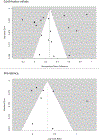Loneliness before and during the COVID-19 pandemic: A systematic review with meta-analysis
- PMID: 35533109
- PMCID: PMC9768682
- DOI: 10.1037/amp0001005
Loneliness before and during the COVID-19 pandemic: A systematic review with meta-analysis
Abstract
The COVID-19 pandemic and measures aimed at its mitigation, such as physical distancing, have been discussed as risk factors for loneliness, which increases the risk of premature mortality and mental and physical health conditions. To ascertain whether loneliness has increased since the start of the pandemic, this study aimed to narratively and statistically synthesize relevant high-quality primary studies. This systematic review with meta-analysis was registered at PROSPERO (ID CRD42021246771). Searched databases were PubMed, PsycINFO, Cochrane Library/Central Register of Controlled Trials/EMBASE/CINAHL, Web of Science, the World Health Organization (WHO) COVID-19 database, supplemented by Google Scholar and citation searching (cutoff date of the systematic search December 5, 2021). Summary data from prospective research including loneliness assessments before and during the pandemic were extracted. Of 6,850 retrieved records, 34 studies (23 longitudinal, 9 pseudolongitudinal, 2 reporting both designs) on 215,026 participants were included. Risk of bias (RoB) was estimated using the risk of bias in non-randomised studies-of interventions (ROBINS-I) tool. Standardized mean differences (SMD, Hedges' g) for continuous loneliness values and logOR for loneliness prevalence rates were calculated as pooled effect size estimators in random-effects meta-analyses. Pooling studies with longitudinal designs only (overall N = 45,734), loneliness scores (19 studies, SMD = 0.27 [95% confidence interval = 0.14-0.40], Z = 4.02, p < .001, I 2 = 98%) and prevalence rates (8 studies, logOR = 0.33 [0.04-0.62], Z = 2.25, p = .02, I 2 = 96%) increased relative to prepandemic times with small effect sizes. Results were robust with respect to studies' overall RoB, pseudolongitudinal designs, timing of prepandemic assessments, and clinical populations. The heterogeneity of effects indicates a need to further investigate risk and protective factors as the pandemic progresses to inform targeted interventions. (PsycInfo Database Record (c) 2022 APA, all rights reserved).
Conflict of interest statement
We have no conflict of interest to disclose.
Figures




References
Publication types
MeSH terms
Grants and funding
LinkOut - more resources
Full Text Sources
Medical
